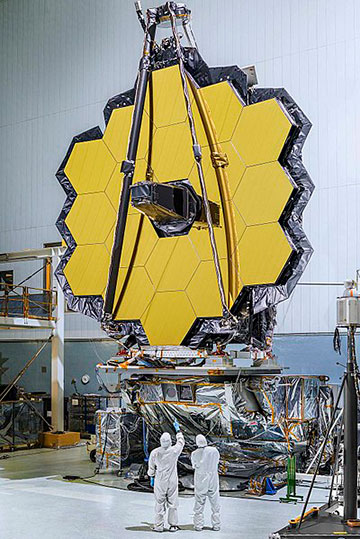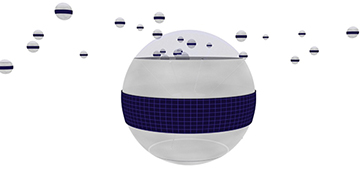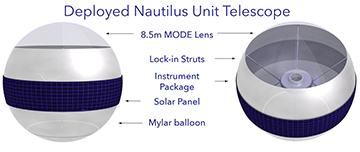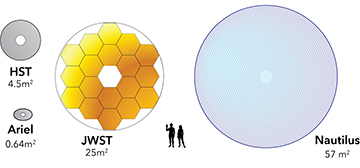The “Nautilus” space telescope concept proposed by Danial Apai and Thomas Milster of the University of Arizona would use a fleet of 35 inflatable balloons, each fitted with an 8.5-m-diameter diffractive lens, to create a spaceborne exoplanet observatory equivalent, in aperture size, to a 50-m-diameter space telescope. [Image: Daniel Apai] [Enlarge image]
The exquisitely crafted, segmented mirrors developed for space-based observing platforms like the James Webb Space Telescope (JWST), and for next-gen Earth-based behemoths like the Giant Magellan Telescope, are marvels of engineering. But some believe that the technology for fashioning large, pristine mirrors for astronomy is starting to run up against practical and physical limits. And that, in turn, could make further advances in light-gathering power increasingly difficult to come by.
Now, astronomers and optical scientists at the University of Arizona (UA), USA, have teamed up to put forward a fundamentally different vision for deep-space astronomy: An array of inexpensive, spaceborne Mylar balloons, each fitted with an 8.5-m diffractive-optics lens and a spectrographic instrument package, and tied together by computer processing (Astron. J., doi: 10.3847/1538-3881/ab2631).
Taken together, the UA team argues, this fleet of inflatable spacecraft—each bearing an uncanny resemblance to an eyeball, peering into the cosmos—could allow astronomers to assess as many as a thousand transiting exoplanets within a 1,000-light-year radius for atmospheric signatures of life. And the researchers believe that the scheme could open up opportunities for universities and other small institutions to launch cost-effective space-based observatories of their own.
The trouble with (big) mirrors

Mirror assembly for the planned James Webb Space Telescope (JWST). The telescope’s technical complexity has caused its launch date to be delayed several times; the current target is for launch in March 2021. [Image: NASA]
The development of large, segmented mirrors for next-generation telescopes, whether on Earth or in space, is all about the quest for more light. A greater area of light-gathering mirror boosts the possibility of collecting stray photons from faint sources like distant extrasolar planets. That imperative has spawned a dazzling collection of mirror technologies, such as the glimmering gold mirror segments of JWST and the ultralight “honeycomb” mirrors being used on the new generation of extremely large telescopes (ELTs) on Earth—along with a suite of sophisticated control systems to maintain the figure of the combined mirror’s segmented surface at nanometer precision.
But as the multiple launch delays of JWST suggest, getting such huge mirrors off the ground, literally and metaphorically, is no easy trick. The authors of the new study suggest that it’s not clear that sufficiently precise mirrors much larger than those for the ELTs currently under construction can be created at all. And even if they can, they face practical constraints, such as how to transport the giant mirror segments to the actual telescope site using the existing highway system.
Further, the study authors argue, even the largest mirrors, either under construction or on the drawing boards, have enough light-collecting power to study only a handful of distant exoplanets. A proper statistical analysis of exoplanet biosignatures—signs of life—requires sample sizes on the order of a thousand candidate planets. That’s “beyond the reach,” the team writes, “of the telescopes envisioned even for the next 40 years.”
From mirrors to MODE lenses
The Nautilus project of the UA team—led by astronomer Daniel Apai of the school’s Lunar and Planetary Laboratory, and by OSA Fellow Thomas Milster of the James C. Wyant College of Optical Sciences—seeks to get around those stumbling blocks. The concept begins by abandoning reflective optics altogether, and relying instead on diffractive optics.
The individual Nautilus units would be packed in stackable form for rocket launch, and inflated into 14-m-diameter Mylar balloons, capped with an 8.5-m-diameter diffractive lens and with the instrument payload in the center, once deployed in space. [Image: Daniel Apai] [Enlarge image]
At the heart of the concept are carefully crafted, 8.5-m-diameter lenses made of a multiorder diffractive engineered (MODE) material. The MODE lenses are analogous to the Fresnel lenses that have been a staple of lighthouses for centuries, but intricately designed and modeled to maximize light-collecting power and minimize weight for the specific purpose of gathering light from extrasolar planets. Molds for the lenses would then be produced using sophisticated modern diamond-tipped tools, allowing dozens of identical lenses to be crafted cheaply from the same design.
Inflatable eyeballs
To get these lenses up to where they can do some good, the team envisions packing them in flat, stackable containers that also include a spectrographic instrument package, a gas canister, and a surrounding sheet of Mylar. About 15 of these pallet-like containers could be accommodated, the researchers estimate, on a launch vehicle like the SpaceX BFR.
Once the packages were transported and deployed, the gas canister would inflate each Mylar sheet into a 14-m-diameter spherical balloon, with the 8.5-m lens at one end, like the crystalline lens in an eyeball. That eyeball’s “retina”—the instrument package—would sit at the lens’ focal plane in the center of the sphere. A belt of photovoltaic film around the Mylar balloon shell would supply power to keep each observatory running.
On an observing campaign for a particular transiting exoplanet, light gathered through the multiple lenses of the fully deployed balloon array would be combined non-coherently via processing on Earth, to allow for detection of molecular species, including possible biomarkers, in the spectroscopic signal. The team suggests that, because the signal is combined non-coherently, precise positioning isn’t important as long as the telescope can see the target star. As a result, intricate “formation flying” of the individual telescopes during the observing campaign wouldn’t be required.
A 50-m aperture
Each of the 8.5-m-diameter diffractive lenses in the Nautilus fleet would have a light-gathering area greater than the combined apertures of the Hubble, JWST and Ariel space telescopes. The project envisions a fleet size of 35 Nautilus spacecraft. [Image: Daniel Apai] [Enlarge image]
The UA team calculates that 35 of these eyeball-like Mylar balloon observatories, each fitted with an 8.5-m diffractive lens, would sport total light-gathering power equivalent to a 50-m spaceborne mirror—far larger than the 6.5-m diameter of the JWST, for example. The 50-m aperture would be enough, the researchers suggest, to allow for a proper statistical analysis of a thousand exoplanets lying within a local radius of 300 parsecs—around 1,000 light years.
The team does acknowledge a few “scalability challenges” in the Nautilus concept. For one thing, diamond-turning and molding technology, on which the production of cheap, replicable MODE lenses would rely, would need to be “scaled up significantly.” The MODE lenses would also need to be protected from damage during launch. And the ability to deploy them remotely in the Mylar balloon observatories, while simple in principle, would need to be demonstrated.
Liberation for astronomers?
These issues notwithstanding, the team is already at work on prototypes to put the design into action. Under a US$1.1 million grant from the Moore Foundation, the researchers aim to test out an Earth-based prototype of the system by December of next year. And their vision for the system, if realized, goes well beyond the key science goal of scanning extrasolar planets for signs of life.
No doubt channeling the frustration of professional astronomers who must compete for scarce observing time at major telescopes, team leader Apai, in a press release accompanying the study, stressed the Nautilus system’s potential—particularly in an era of private-sector space ventures and CubeSats—to democratize observing capabilities. Using this low-cost, replicable technology, “universities would be able to launch their own Earth- or space-observing telescopes,” he said. “Instead of competing for bits of time on Hubble, they’d get their own telescope, controlled by their own teams.”



